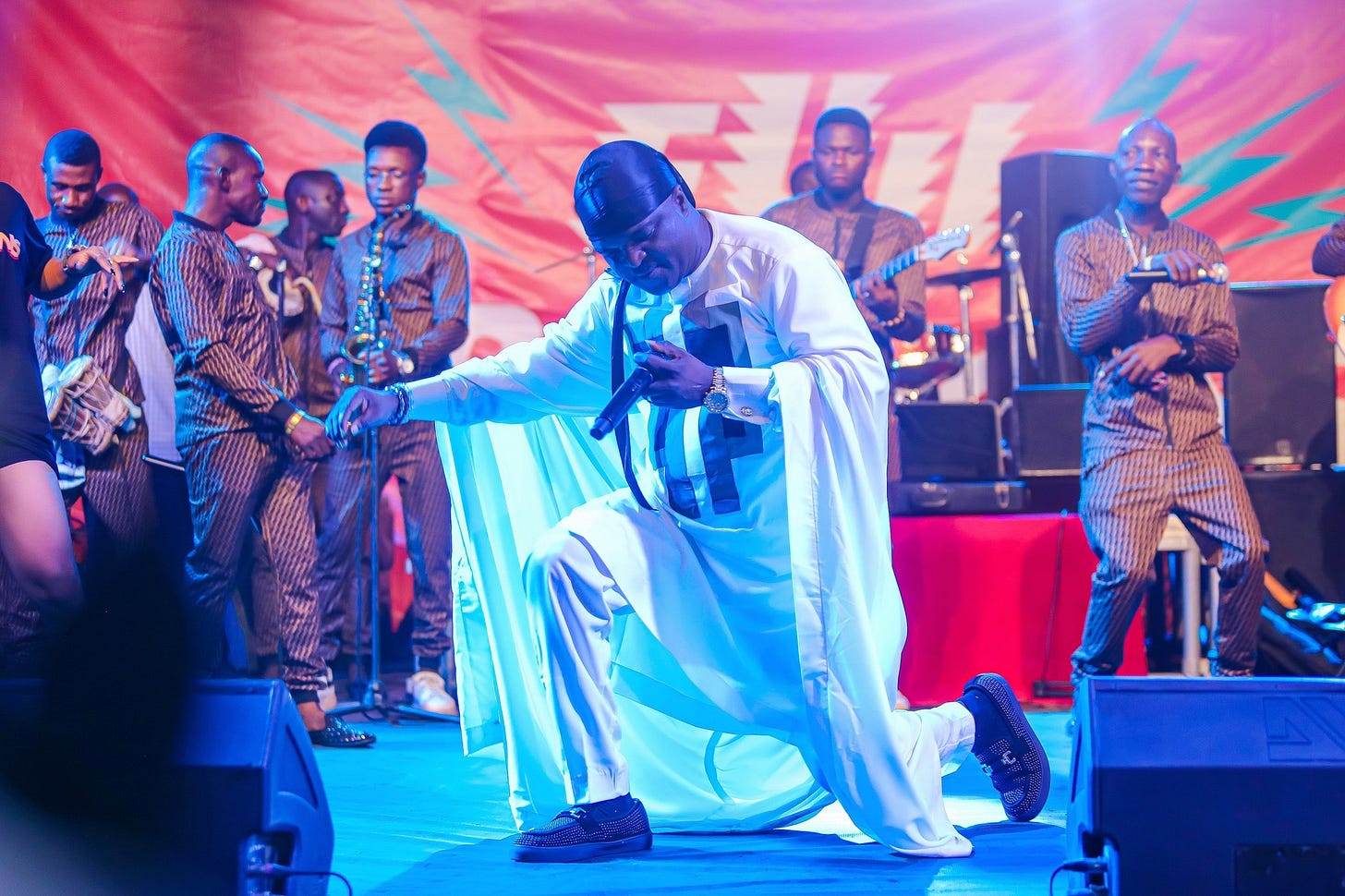Why Afrobeats Inherited Fuji's Energy, Not Highlife or Juju's Groove
One day, the cock of the walk...
Asake on stage at Madison Square Garden. Photo credit Rolling Stone.
“Fuji sound is combination of music, consisting of sakara, apala, juju, Afro, gudugudu, aro; possibly, highlife…” - Fuji Reggae Series II; Alhaji Sikiru Ayinde Barrister & His Londoner Fuji Exponents (1979).
In November, I was invited to join a panel at Art X Live, a segue of the annual arts festival where Lagos one-percenters cosplayed Art Basel at Victoria Island’s Federal Palace Hotel. The irony wasn’t lost on me that whilst most attendees (and curators, in fact) were foreign in either upbringing or education, there appeared to be a fascination with Fuji music and a desire to explore the possible connections between that unashamedly Yoruba genre and what currently interests the multi-ethnic, cross-cultural audiences of today. A few weeks later, at the 70 Years of Music in Nigeria exhibition by Pop Central TV (co-curated in part by yours truly), I hosted yet another town hall session that sought to discuss the evolution of traditional genres like Highlife, Juju, and Fuji in the modern era. The final question I got at both sessions by evidently younger music fans was how to distinguish which was which among these three genres.
It’s an understandable poser, given their age and frail standing in today’s pop culture. My reply? All three are identifiable by the dominant instruments in their composition: Highlife is melodic, guitar- or brass-driven, depending on the leaning of the band leader (see Victor Olaiya, Rex Lawson vs. Osita Osabebe, Victor Uwaifo, et al.). Juju, despite its origin in Palmwine Music and Highlife, platformed the guitar as the lead instrument. The early recordings of Tunde King and Irewole Denge, as far back as the 1930s, sparse as they were, clearly presented the box guitar as the instrument of choice, accompanied by a couple of drums. Fuji, on its part, was led by Yoruba traditional percussion, mainly sakara and omele, while incorporating many other instruments across various genres. The opening lede of this piece, declared by the inventor of that genre, succinctly describes its essence: it is a fusion.
However, as the 21st-century phenomenon Afrobeats continues to trace its genealogy and hopefully find a soul, it is fair to wonder aloud why today’s Afrobeats appears to lean more into Fuji than when it began its ascension some twenty-five years ago now. Bayo Omisore, writer, culture OG, and Elder, thusly commented in response to the incredibly cerebral Dami Ajayi, who this past week published this piece: Will the Real Juju OGs Please Sit Down? For full disclosure, I like to think I’m somewhat of a “Fuji head," having done some work in that space, from podcasts to Fuji Opera. Beyond that, I thoroughly enjoy Fuji music, so much that my wife once profusely thanked my mother for ensuring that I stayed in school because I very well could have held court at the junction of my family house in Mushin and been the resident onile. But the joke’s on them really: Hip-Hop captured my heart in 1992, and I tried to be a rapper in secondary school. I digress.
Before now, the charge against Fuji has been its apparent inherent “razzness.” Unlike Highlife, which by its name connotes an elevated lifestyle superior to what obtains amongst the masses, and Juju, which followed in its stead and catered to the emerging upper middle class of 1970s and 80s Nigeria, Fuji is blue-collar. It is—or was—for the working class. It is perceived to embody a lack of sophistication that is normally associated with Highlife or Juju. Little wonder that in the above-referenced Barrister record, he went on to dismiss the uppity opinions of those who referred to Fuji at the time as “local sound.” It’s a perception that exists still, despite the almost universally acknowledged influences on superstars such as Burna Boy and Asake, or for that matter, on Yinka Ayelefe, SB Live, Akin Shuga, and the hordes of Juju-raised-but-Fuji-leaning Owambe bands that continue to operate under the Juju umbrella. For all of their storied bourgeoisieness, Highlife and Juju have not kept up with Fuji in terms of evolution, innovation, and popularity. I have a few thoughts as to why—or why not.
Pop culture and urban life are the driving forces behind any popular music. Juju overtook Highlife and its attendant colonial-era sound and lyrics in the 1970s, owing to the edginess of newly minted stars in King Sunny Ade, Chief Commander Ebenezer Obey, and everyone who followed them. Twenty years later, Obey had forsaken the stage for the pulpit, while Sunny had to contend with the rising Fuji music bands that boldly snatched the mic from them. It is instructive that the youngest and biggest Juju superstar of that era, Sir Shina Peters, to date credits Barrister for encouraging him to incorporate the fast-tempo omele into his repertoire. In a nutshell, the mellow groove of Juju is basically boring to successive generations of music fans who want something to dance to. In the case of Afrobeats, the urban pop music of the millennium has more in common with American Hip Hop than it does Highlife or Juju. I once drew a parallel between Hip Hop and Fuji here.
More importantly, Highlife and Juju’s aversion to evolution may have cost it the pride of place and sadly made it an endangered species. Of course, it’s not their fault that their musicians need to also be instrumentalists in contrast to Fuji, where percussive dominance is king. Highlife and Juju, no matter how up-tempo they get, they return to their steady, unhurried flow. Yet, through the years, Fuji has embraced other genres more than they have it. Think Pasuma’s association with Remedies in 1999 to his flirt with Amapiano in 2021. Or Saheed Osupa’s constant insertion into popular culture, either in films or on Masoyinbo. It’s safe to wager that Juju or Highlife has never had a counter-culture practitioner like Obesere. K1, the de facto leader of the Fuji genre, has experimented with Dancehall, Hip Hop, Afrobeats, and everything in between. Sikiru Ayinde Barrister, in his lifetime, included Hawaiian guitars and saxophones in his band. To have a lasting influence on popular culture, music genres and their practitioners must be willing to go against the grain. Highlife and Juju have hardly done that.
In a generation where attention span is just about the length of a YouTube ad, the ability to adapt and evolve is crucial for continued existence. Artists must be willing to be willing to push boundaries. All of the greats did so, before, as Dami Ajayi put it, a lifetime of playing music caught up with them. Six or seven years ago, I moderated a panel put together as part of a campaign by a lager brand. K1 and SSP were on that panel, so I pointedly asked them why their respective genres were playing catchup to Afrobeats. Shina Peters answered first, launching into a long harangue about how today’s fans had little respect for their artistry, that patrons don’t pay enough for his 25-member band, etc. K1, his lifelong friend, disagreed loudly. According to him, his booking fee was in tiers, and he was willing to take on all comers as long as it didn’t clash with prior engagements. He also pointed to his 2001 album, “The Message”, which he said was a solo digital recording. Shina grimaced. In that brief moment, it became apparent to me the gulf between these two icons of Nigerian music and why one is in more demand than the other.
Afrobeats is a relatively young genre. Perhaps at a later date, I will theorize as to why it is in need of a soul and why those who choose to eschew the nomenclature for “Afro-fusion” are being cute - Afrobeats IS a fusion. But wherever Afrobeats has travelled, its innate energy is its calling card. That energy has its source in Fuji.
Nonetheless, K1 is 68 years old this year. Obesere turns 60 next week. Pasuma is 57. Saheed Osupa is 55. I cannot remember the last starlet that the genre produced after Shanko Rashidi twenty years ago, which leads me to fear, that Fuji itself might be in danger of extinction. That is a matter for another day.
This past November, my family experienced a bereavement from which we’re still reeling. But in that time, we’ve been surrounded with so much love, kindness, and support that helps us get through each day. We’re grateful to all of you, our friends. I’ll be back.







